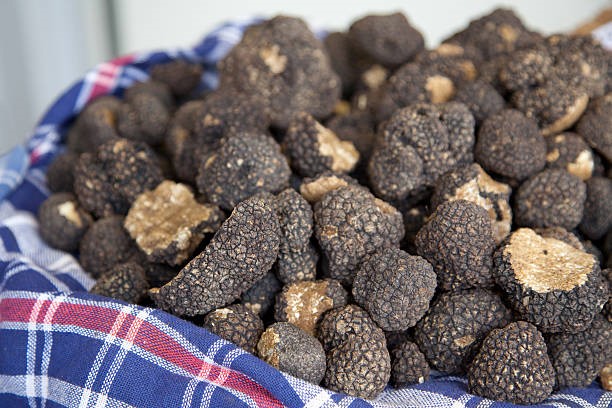Truffles, those enigmatic fungi, possess an allure that transcends their humble origins in forested landscapes to their exalted status on gourmet plates around the world. This journey from forest to fork is a tale interwoven with mystique, scarcity, and culinary excellence, shaping a market characterised by exclusivity and high value.
The Origin
Truffles, often referred to as the “diamonds of the kitchen,” grow underground in symbiosis with the roots of certain trees, primarily oak, hazel, beech, and chestnut. They thrive in specific climates and soils, most notably in regions across Europe—France, Italy, Spain—along with parts of the United States, Australia, and China.
Their elusive nature and reliance on natural conditions, including specific soil, moisture, and temperature, make them challenging to cultivate, adding to their rarity and market value. Truffle hunters and their trained dogs or pigs embark on a quest through forests, guided by tradition and intuition, seeking these hidden treasures.
Harvesting and Market Dynamics
The harvesting process is as ancient as it is meticulous. Truffle hunters, armed with their keen-scented companions, traverse the woodlands, employing age-old techniques passed down through generations. This traditional approach to harvesting contributes to the mystique and romanticism surrounding truffles.
Once unearthed, fresh truffles are swiftly transported to markets or directly to distributors to preserve their freshness and fragrance. The immediacy of their transfer from forest to market is crucial, as truffles lose their aroma and value rapidly after being removed from the ground.
Culinary Delicacy
Renowned for their distinctive aroma and flavour, truffles hold a coveted place in haute cuisine. Chefs worldwide venerate these fungi for their ability to elevate dishes, imparting an earthy, musky, and pungent essence to culinary creations. Whether shaved atop pasta, infused into oils, or incorporated into sauces, truffles tantalise the taste buds and evoke a sense of culinary opulence.
The rarity and seasonal nature of fresh truffles further heighten their desirability, with the peak season varying depending on the species and location. White truffles from Alba, Italy, command the highest prices and prestige, often fetching thousands of dollars per pound during their brief autumnal season.
What Determines The Market Value of Truffles?
The market value of truffles, those esteemed fungi sought after by gourmets and chefs alike, is influenced by a myriad of factors that contribute to their scarcity, desirability, and market dynamics. Understanding these determinants provides insights into why truffles command such high prices.
Species and Rarity
Different truffle species vary in taste, aroma, and rarity. The most sought-after include the White Truffle (Tuber magnatum) and the Black Truffle (Tuber melanosporum). The scarcity of certain species, especially those with exceptional aroma and taste profiles, significantly impacts their market value.
Seasonality and Harvest Quantity
Truffles are seasonal. The limited window of availability, typically spanning a few months, affects their price. Factors like weather conditions and environmental changes influence the annual harvest quantity. A poor season or reduced yield due to climate variations can drive prices higher due to decreased supply.
Geographical Origin
Truffles are strongly associated with specific regions known for their unique terroir, contributing to their distinct flavours and aromas. Truffles from renowned areas like Alba in Italy or Périgord in France carry premium value due to their established reputation for producing superior-quality truffles.
Quality and Freshness
The quality and freshness of truffles significantly impact their price. Factors such as size, shape, aroma intensity, and absence of blemishes or imperfections dictate their value. Freshly harvested truffles with potent aromas and unblemished appearances command higher prices compared to older or lower-quality specimens.
Demand and Culinary Trends
The demand for truffles in the culinary world plays a pivotal role in price determination. As these fungi are synonymous with gourmet cuisine and culinary luxury, shifts in culinary trends and increased demand from high-end restaurants and consumers can drive prices upward.
Harvesting Challenges
The labour-intensive and unpredictable nature of truffle harvesting contributes to their high prices. Truffle hunting requires specialised knowledge, trained animals, and the ability to navigate forests in search of these elusive fungi. This traditional method of harvesting is both time-consuming and reliant on natural conditions, adding to production costs.
Market Speculation and Auctions
The truffle market is susceptible to speculation, especially during high-demand periods. Auctions, where notable specimens are showcased and sold to the highest bidders, create an atmosphere of exclusivity and competition, resulting in inflated prices.
Transport and Shelf Life
Truffles have a limited shelf life once harvested. Their delicate nature necessitates rapid transportation to preserve their freshness and aroma. Costs associated with swift transportation and the need for careful handling contribute to their overall price.
Currency Fluctuations and Economic Factors
Global economic conditions, currency fluctuations, trade tariffs, and geopolitical influences can impact the pricing of truffles. Changes in exchange rates or economic instability in truffle-producing regions can affect both supply chains and pricing.
Regulations and Legal Restrictions
Government regulations and restrictions on harvesting, trade, and exportation can influence the availability and cost of truffles. Conservation efforts and regulations aimed at protecting truffle habitats may limit harvest quantities, affecting market supply and prices.
The price of truffles reflects a delicate interplay of factors, including rarity, seasonality, quality, demand, production challenges, and market dynamics. This convergence of elements contributes to the aura of exclusivity and high value associated with these elusive and revered culinary treasures.
Conclusion
The journey of fresh truffles from forest to fork embodies a captivating narrative, weaving together tradition, scarcity, culinary excellence, and economic significance. Their allure transcends their humble origins, captivating the senses and captivating the palates of connoisseurs worldwide.
The mystique and market value of fresh truffles persist as a testament to their elusive nature, entrenched in a delicate ecosystem that continues to fascinate and enthrall both aficionados and those newly introduced to their aromatic splendour. As innovations and traditions intersect, the journey of fresh truffles and their market value continues to evolve, preserving the legacy of these extraordinary fungi in the annals of gastronomy.
